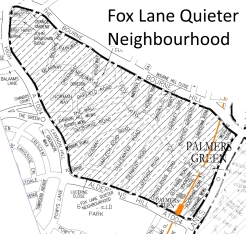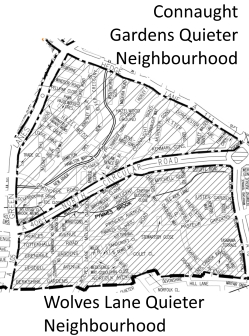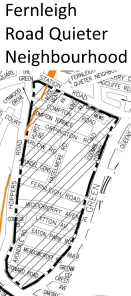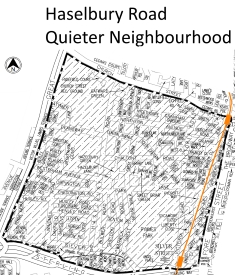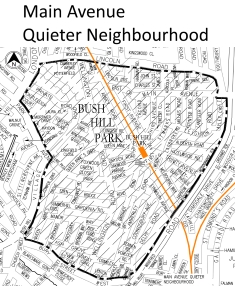Forum topic: "Quieter Neighbourhoods" consultation to start soon
"Quieter Neighbourhoods" consultation to start soon
Basil Clarke
05 Nov 2014 14:54 #496
- Basil Clarke
-
 Topic starter
Topic starter
Share
![]()
![]() Share by email
Share by email
Palmers Green Community has obtained information about the extent of the "Quieter Neighbourhoods" that Enfield Council is planning to create in and around Palmers Green. At next week's open meeting of Fox Lane and District Residents' Association the Council is expected to provide some more details of what exactly they have in mind and how they intend to consult. Non-members of FLDRA who live within the Association's area - that bounded by Green Lanes, Bourne Hill, The Bourne, High St.N14, Cannon Hill and Aldermans Hill - will be welcome at the meeting.
The Council's intention is to eventually create Quieter Neighbourhoods throughout the borough, covering as many as 37 residential areas. The maps that we have obtained show the boundaries of six Quieter Neighbourhoods oovering parts of Palmers Green, Southgate, Winchmore Hill, Edmonton and Bush Hill Park:
- Fox Lane Quieter Neighbourhood
- Connaught Gardens Quieter Neighbourhood
- Wolves Lane Quieter Neighbourhood
- Fernleigh Road Quieter Neighbourhood
- Haselbury Road Quieter Neighbourhood
- Main Avenue Quieter Neighbourhood
The maps below show the locations of these neighbourhoods - click on a map for a larger version.
What exactly is a Quieter Neighbourhood?
The Quieter Neighbourhoods concept was first mentioned by the Council in its bid document for the Mayor of London's "Mini-Holland" money, though in that document they are referred to as "Residential Cells". The Cells as described in the bid document are closely modelled on current practice in Holland. While for obvious reasons the Mini-Holland bid document emphasizes the advantages of the cells/neighbourhoods for cyclists, it is clear that there is a broader objective - to make life more peaceful, pleasanter and safer for people living in the hundreds of residential streets that are located within the cells created by the network of primary and secondary through roads - primarily through reducing "rat-running" and slowing down cars.
I've extracted relevant text from the main Mini-Holland bid document to show what the Council had in mind at the time (late 2013):
Our long term goal is to create this Dutch-style network of residential cells across Enfield [...]
We will [...] work with five to six residential cells per year, throughout the duration of the mini-Holland project to treat residential areas, particularly those where speeding traffic and rat running is a problem.
In the Netherlands, main cycle routes through residential areas are designated as ‘fietsstraat’, or bicycle streets. On these streets automobiles are ‘guests’ and motorists must yield to cyclists. Again, consistent signage and road markings signal the type of road and appropriate behaviour to motorists (as shown in the photos below).
The effect of the approach outlined above is to create a grid network of primary and secondary roads for through traffic with appropriate facilities for cyclists, and within the 'grid' residential cells comprised of tertiary roads are created (as shown on our network map, we have identified 37 residential cells).
The Dutch approach to these cells is as shared spaces where speeds and through traffic are reduced to ensure cycle safety. The outer edges of these cells have consistent signage and design features, such as entry treatments that signal to motorists to lower their speeds (as shown in the photo). In the Netherlands, these cells provide a safe network for cyclists, including children cycling to school or to visit friends.
[...]
Enfield Council is working with Sustrans on a DIY Streets project in Edmonton Green. This project is using a community-led design approach to improve the streetscape for children, pedestrians and cyclists. Through a series of on street ‘pop-up’ events the local community are invited to discuss the problems they face in their area. Residents are also contacted through schools, residents associations, community events and leaflets. Once this background data has been collected on an area, residents are invited to attend workshops and to discuss potential solutions for the problems. Typical problems include rat running, speeding traffic, poor pedestrian and cycling environments and busy roads.
An urban designer then uses the information gathered at these workshops to draw up options to improve the area. These options are then consulted on and the chosen scheme is piloted on street using, for example, sandbags and straw bales. If the pilot is successful, the scheme progresses to the engineering stage. If not, tweaks are made until a solution is agreed upon.
As detailed in section 3, we have identified approximately 37 residential ‘cells’ in Enfield. Our goal is to remove through traffic from these residential streets, so that only residents access these areas. This will provide a whole network of calm and inviting streets for pedestrians and cyclists, where traffic volumes and speeds are low and segregated facilities are not required. We will treat each ‘cell’ individually, using the community-led design approach detailed above ensuring that residents, schools, local traders and community groups are encouraged to participate in the designs of the schemes. This strand of the strategy will be delivered by the Mini-Holland Community Engagement officer and Urban Designer, with training support from Sustrans. The results of each scheme will be monitored using both qualitative and quantitative data, as set out in our monitoring proposal.
The results of the evaluations will be communicated with residents in new treatment areas, so that they can see the impact these measures have had on quality of life and other indicators. It is hoped that this approach will help foster support from the local community for proposed changes to the streetscape.
It would appear that the Council does not wish to impose a one-size-fits-all model for the Quieter Neighbourhoods, but instead will work with residents to develop schemes that suit each individual area. Consultation has already begun for the Wolves Lane scheme and the Fox Lane meeting next week will mark the start of work on the largest of the areas - extending all the way from Palmers Green Triangle to Southgate Circus.
Please Log in or Create an account to join the conversation.
"Quieter Neighbourhoods" consultation to start soon
Karl Brown
07 Nov 2014 16:53 #497
- Karl Brown
-

Share
![]()
![]() Share by email
Share by email
Please Log in or Create an account to join the conversation.
"Quieter Neighbourhoods" consultation to start soon
Paul Mandel
09 Nov 2014 00:29 #502
- Paul Mandel
-

Share
![]()
![]() Share by email
Share by email
We’ll know more what this will entail in the coming weeks. But, the following is likely to be on the cards.
1. 20 mph speed limits. 20 mph is too fast in many places and 30 mph is safe in others. Unnecessary and unreasonable 20 mph limits are frustrating, leading to them being almost universally disregarded by road users, and resulting reduced respect of the law generally.
Better to enforce a 30 mph speed limit and ensure all adult road users accept individual responsibility for their own actions and that children are given good road safety education at school.
2. Traffic calming measures.
Speed humps cause discomfort for drivers and riders including cyclists, encourage harsh braking and acceleration and they are largely unnecessary away from junctions, where mini roundabouts and speed tables are better solutions.
Chicanes and other narrowing also result in more braking and acceleration leading to increase pollution. They can be dangerous for cyclists when other vehicles overtake at the constrictions. They also reduce the space available for parking.
3. Closing of entrances on to main roads to eliminate so called “rat running”. This could actually increase vehicle movement within the “quieter neighbourhood” as drivers have to travel further to the remaining entrances and exits. At times where one of the surrounding main roads are blocked, local residential through roads enabling traffic to bypass an obstruction, preventing gridlock, that would occur if the council creates closed cells.
So to conclude: Without care in their design and implementation, so called “quieter neighbourhoods” will become frustrating neighbourhoods to get in, out and around.
Please Log in or Create an account to join the conversation.
"Quieter Neighbourhoods" consultation to start soon
Karl Brown
09 Nov 2014 12:37 #503
- Karl Brown
-

Share
![]()
![]() Share by email
Share by email
But if there is a call for change we will also have the opportunity to assess subsequently developed mitigating proposals. And that seems entirely reasonable as an approach with no need to second guess or act as an anticipatory pseudo-traffic engineer.
Please Log in or Create an account to join the conversation.
"Quieter Neighbourhoods" consultation to start soon
Paul Mandel
09 Nov 2014 14:57 #504
- Paul Mandel
-

Share
![]()
![]() Share by email
Share by email
Ah yes, the area WITHIN, The Bourne, Bourne Hill Green Lanes, Aldermans Hill, Cannons Hill, and High Street Southgate, is a steamy cocktail of traffic congestion, pollution, antisocial behaviour and violent and drug crime, compared with most ather parts of London. All the local estate agents know that, don’t they.
In fact the only significant problem that may put off some people moving into the area is the problem of school catchments.
And no, I’m not second guessing a thing. Furthermore, I’m better qualified to give an opinion than you may think. Don’t be so patronising in your tone towards this "pseudo traffic engineer."
Best wishes.
Paul
Please Log in or Create an account to join the conversation.
"Quieter Neighbourhoods" consultation to start soon
David Hughes
09 Nov 2014 21:57 #507
- David Hughes
-

Share
![]()
![]() Share by email
Share by email
Streets used to be alive with neighbourly activity - called community I'm led to believe- which old as I am I remember well; people chatting, kids playing, learning to ride their bikes. The arrival of cars need not have destroyed these strong communities, but it did. At first because the experience of speed is so different inside a vehicle than outside, but now also because the car has become the default way of travel whatever the circumstance or distance. We have a new mindset. Paul M.shows every sign of being at the extreme end of that change.
There is huge concern in Britain's medical fraternity about the effect of lack of exercise and poor air quality on health and longevity, and plenty of evidence of the fact that society at large no longer gets enough exercise from the daily requirements of living such as walking. And who suffers most? Kids of course, who have been deprived of their independence to a scandalous extent. Mind you biking - if you can't both walk and bike - is an excellent way of exercising. One up to the council.
Please Log in or Create an account to join the conversation.
"Quieter Neighbourhoods" consultation to start soon
Karl Brown
10 Nov 2014 10:26 #509
- Karl Brown
-

Share
![]()
![]() Share by email
Share by email
Other aspects such a drug crime, outside the clear remit of Cycle Enfield, would seem best raised via specific threads on those topics.
Please Log in or Create an account to join the conversation.
"Quieter Neighbourhoods" consultation to start soon
Karl Brown
10 Nov 2014 10:26 #510
- Karl Brown
-

Share
![]()
![]() Share by email
Share by email
Other aspects such a drug crime, outside the clear remit of Cycle Enfield, would seem best raised via specific threads on those topics.
Please Log in or Create an account to join the conversation.



